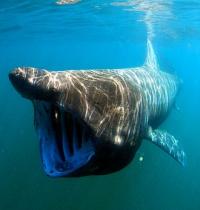 Aerial surveys attempting to identify endangered right whales have spotted swarms of basking sharks, in groups from 30 to up to 1,400, swimming in the waters from Long Island to Nova Scotia. Researchers who study the normally solitary sharks are not quite sure why. Nevertheless, reviews of the data suggest that such gathering are not that unusual. NOAA issued a press release on the sightings which said in part:
Aerial surveys attempting to identify endangered right whales have spotted swarms of basking sharks, in groups from 30 to up to 1,400, swimming in the waters from Long Island to Nova Scotia. Researchers who study the normally solitary sharks are not quite sure why. Nevertheless, reviews of the data suggest that such gathering are not that unusual. NOAA issued a press release on the sightings which said in part:
The reason why the animals congregate has not been clearly determined, although it is thought to be related to feeding, socializing, and/or courtship given behaviors in other shark species.
In a recent study reported in the Journal of Fish Biology, researchers analyzed aggregations of basking sharks (Cetorhinus maximus) recorded off the northeastern United States coast to learn more about the phenomenon. Observations of these aggregation events are relatively rare. In almost 40 years of aerial surveys for right whales, ten large basking shark aggregation events were opportunistically recorded and photographed. Comparing this information with that collected in a number of earth-orbiting satellite and oceanographic databases and by the NEFSC’s ecosystem monitoring (EcoMon) cruises in the same region, researchers obtained more insight into this behavior.
“Aerial surveys provide a valuable perspective on aggregations and their potential functions, especially when coupled with environmental satellite and ship-based survey data,” said Leah Crowe, a protected species researcher at NOAA’s Northeast Fisheries Science Center and lead author of the study. The researchers found the aggregations occurred in summer and fall when sea surface temperatures ranged between 55 and 75 degrees F (13 to 24 degrees C). In the largest event, data were available to indicate there was a high concentration of zooplankton prey present.
While basking sharks are the second largest shark, next only to the whale shark, they are no threat to humans. The basking shark can reach up to 32 feet long but are plankton feeders.
